
 |
|
The Lord of the Rings: The Two Towers (2002)  Directed by Peter Jackson Cast: Elijah Wood, Viggo Mortensen, Sean Astin, Orlando Bloom, Ian McKellen, John Rhys-Davies, Billy Boyd, Dominic Monaghan, Christopher Lee, Andy Serkis, Miranda Otto, Brad Dourif, Bernard Hill, Liv Tyler, Hugo Weaving, Karl Urban, Cate Blanchett, David Wenham 2002 – 179 minutes Rated: Reviewed by Dustin Putman, December 19, 2002. 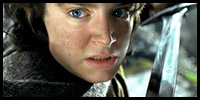 "The Lord of the Rings: The Two Towers" is almost precisely the same length as its gloriously astounding predecessor, "The Fellowship of the Ring," yet seems notably longer and with little of worth occurring in its three-hour running time. Based on the novel by J.R.R. Tolkien, the most disheartening thing about this middle installment of the vastly popular, epic fantasy trilogy is its sudden loss of focus, character nuance, and storytelling fluidity. Whereas director Peter Jackson effortlessly weaved the tale of "The Fellowship of the Ring" with intrigue and awe, his approach to "The Two Towers" is more uneven and by-the-numbers. He hops back and forth between subplots and characters and, while the visuals are still amazing, there is no joy, little energy, and a "stop-and-start" pace to the proceedings this time around.
"The Lord of the Rings: The Two Towers" is almost precisely the same length as its gloriously astounding predecessor, "The Fellowship of the Ring," yet seems notably longer and with little of worth occurring in its three-hour running time. Based on the novel by J.R.R. Tolkien, the most disheartening thing about this middle installment of the vastly popular, epic fantasy trilogy is its sudden loss of focus, character nuance, and storytelling fluidity. Whereas director Peter Jackson effortlessly weaved the tale of "The Fellowship of the Ring" with intrigue and awe, his approach to "The Two Towers" is more uneven and by-the-numbers. He hops back and forth between subplots and characters and, while the visuals are still amazing, there is no joy, little energy, and a "stop-and-start" pace to the proceedings this time around.
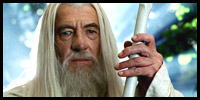 Having clear knowledge of the plot points and characters introduced in "Fellowship" is essential for understanding the follow-up. Instead of offering up a tidy summary of what has already occurred, Jackson courageously drops viewers in the middle of three separate storylines, at the point where each of them left off in the past film. Because I had watched "Fellowship" less than twenty-four hours prior to seeing "The Two Towers," the passage to reacquainting myself with the characters and their plight was remarkably easy. To my dismay, however, something was slightly askew here. The setting of Middle-Earth was lacking the sense of discovery it once held; the majority of characters were simply going through the paces rather than further evolving; and the pacing seemed inconsistent and choppy in comparison to the previous picture's smooth, humanistic involvement.
Having clear knowledge of the plot points and characters introduced in "Fellowship" is essential for understanding the follow-up. Instead of offering up a tidy summary of what has already occurred, Jackson courageously drops viewers in the middle of three separate storylines, at the point where each of them left off in the past film. Because I had watched "Fellowship" less than twenty-four hours prior to seeing "The Two Towers," the passage to reacquainting myself with the characters and their plight was remarkably easy. To my dismay, however, something was slightly askew here. The setting of Middle-Earth was lacking the sense of discovery it once held; the majority of characters were simply going through the paces rather than further evolving; and the pacing seemed inconsistent and choppy in comparison to the previous picture's smooth, humanistic involvement.
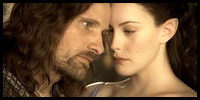 As "The Two Towers" gets underway, hobbits Frodo (Elijah Wood) and Sam (Sean Astin) continue their journey to the city of Mordor in order to destroy the corruptive ring in the fires of Mount Doom. When they lose their way and start going around in circles, a chance meeting with emaciated creature Gollum (Andy Serkis)—a former ringbearer who has been driven mad by its powers—places him in the role of guide to Frodo and Sam.
As "The Two Towers" gets underway, hobbits Frodo (Elijah Wood) and Sam (Sean Astin) continue their journey to the city of Mordor in order to destroy the corruptive ring in the fires of Mount Doom. When they lose their way and start going around in circles, a chance meeting with emaciated creature Gollum (Andy Serkis)—a former ringbearer who has been driven mad by its powers—places him in the role of guide to Frodo and Sam.
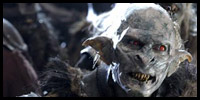 Meanwhile, the human Aragorn (Viggo Mortensen), elf Legolas (Orlando Bloom), and dwarf Gimli (John Rhys-Davies) set out to find hobbits Merry (Dominic Monaghan) and Pippin (Billy Boyd), who have been kidnapped by the evil Saruman's (Christopher Lee) ghastly Orc henchmen. Their search is sidetracked to the city of Rohan, where Aragorn hopes to convince King Theoden (Bernard Hill) that an impending war is about to fall on his kingdom. At the same time, Merry and Pippin manage to escape into the Fanghorn Forest, where they meet and befriend an Ent known as Treebeard (voiced by John Rhys-Davies), who acts as shepherd to the rest of the living trees in the forest.
Meanwhile, the human Aragorn (Viggo Mortensen), elf Legolas (Orlando Bloom), and dwarf Gimli (John Rhys-Davies) set out to find hobbits Merry (Dominic Monaghan) and Pippin (Billy Boyd), who have been kidnapped by the evil Saruman's (Christopher Lee) ghastly Orc henchmen. Their search is sidetracked to the city of Rohan, where Aragorn hopes to convince King Theoden (Bernard Hill) that an impending war is about to fall on his kingdom. At the same time, Merry and Pippin manage to escape into the Fanghorn Forest, where they meet and befriend an Ent known as Treebeard (voiced by John Rhys-Davies), who acts as shepherd to the rest of the living trees in the forest.
Not surprisingly, "The Lord of the Rings: The Two Towers" is a visual dazzler, and the amount of sheer technical artistry that went into the production is staggering. The sweeping cinematography, by Andrew Lesnie, is sumptuously triumphant, and the visual effects are first-rate. The work put into Gollum is most impressive of all, as the role was voiced and performed by Andy Serkis, and then transformed into the most believable computer-generated character to ever grace the silver screen. Not only is Gollum the most three-dimensional figure in the Middle Earth universe, an alternately frightened and frightening creature whose personality has been split into two, but Serkis delivers one of the most stunning performances of the year. The CG Ents are less successful, if only because of the challenge in personifying a plant. They look fine, but too often resemble Rock Biter from "The Neverending Story." 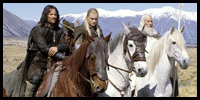 One of the most gratifying things about "The Fellowship of the Ring" was in experiencing a humane, beautifully told fantasy epic that took its exciting and rich material with a rare seriousness. "The Two Towers" holds no such scrutiny, often feeling aimless and drug out. While the predecessor centered on young Frodo, here the central focus is handed to warrior Aragorn, a bland hero who has few interesting character traits. The seemingly endless section set in Rohan, which introduces several new characters to the trilogy and sets up a half-hearted love triangle between Aragorn, fellow human Eowyn (Miranda Otto), and immortal elf Arwen (Liv Tyler), halts the film to a veritable stop. The subplot concerning Merry and Pippin's relationship with Treebeard is also undernourished. Their sparse scenes throughout are thoroughly disposable until the climax, in which Treebeard is given a reason for his appearance in the film. "The Fellowship of the Rings" does not have a dry or uninteresting moment in its 178 minutes; "The Two Towers," on the other hand, has more than can be counted on two hands.
One of the most gratifying things about "The Fellowship of the Ring" was in experiencing a humane, beautifully told fantasy epic that took its exciting and rich material with a rare seriousness. "The Two Towers" holds no such scrutiny, often feeling aimless and drug out. While the predecessor centered on young Frodo, here the central focus is handed to warrior Aragorn, a bland hero who has few interesting character traits. The seemingly endless section set in Rohan, which introduces several new characters to the trilogy and sets up a half-hearted love triangle between Aragorn, fellow human Eowyn (Miranda Otto), and immortal elf Arwen (Liv Tyler), halts the film to a veritable stop. The subplot concerning Merry and Pippin's relationship with Treebeard is also undernourished. Their sparse scenes throughout are thoroughly disposable until the climax, in which Treebeard is given a reason for his appearance in the film. "The Fellowship of the Rings" does not have a dry or uninteresting moment in its 178 minutes; "The Two Towers," on the other hand, has more than can be counted on two hands.
The final hour, already affectionately known as the Battle at Helm's Deep, casts Saruman's hundreds of thousands of forces against the people of Rohan, with aid from Aragorn, Gimli, and Legolas. Prematurely being labeled as the most brilliantly orchestrated sequence of combat ever captured on film, the battle scene has a suspenseful and arresting build-up and then feels anticlimactic when it finally arrives. While it is, indeed, a technical masterpiece, it forgets to build any sense of momentum or true danger. Every time the scene gets going, the film monotonously cuts to characters not involved in Helm's Deep. The lackluster music score, by Howard Shore, also may be a major culprit; aside from the majestic theme, the orchestrations leave something to be desired. 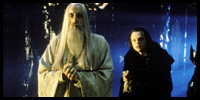 There are more flaws in "The Two Towers," if you can believe it. While "The Fellowship of the Ring" was only the first part of a trilogy, it felt like a complete whole—a marvelous introduction to things to come. Here, vague story details and plot holes bombard the action. When Gandalf the Gray (Ian McKellen), who was believed to have died, miraculously returns after defeating a fire demon, he seems and acts different, and not only because he is now called Gandalf the White. The details involving his personality and physical changes (not to mention his very survival) are hurriedly tiptoed over with nearly no explanation. Perhaps a future director's cut will shed some light on the many unclear elements; the current incantation feels like more of a cliff's notes version of "The Lord of the Rings."
There are more flaws in "The Two Towers," if you can believe it. While "The Fellowship of the Ring" was only the first part of a trilogy, it felt like a complete whole—a marvelous introduction to things to come. Here, vague story details and plot holes bombard the action. When Gandalf the Gray (Ian McKellen), who was believed to have died, miraculously returns after defeating a fire demon, he seems and acts different, and not only because he is now called Gandalf the White. The details involving his personality and physical changes (not to mention his very survival) are hurriedly tiptoed over with nearly no explanation. Perhaps a future director's cut will shed some light on the many unclear elements; the current incantation feels like more of a cliff's notes version of "The Lord of the Rings."
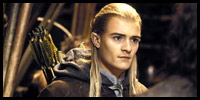 In the performance arena, the aforementioned Andy Serkis (as Gollum) steals the film. His co-stars Elijah Wood, as Frodo, and Sean Astin, as Sam, deepen the bond they have as friends (and maybe more, if you ask me) even as Frodo is gradually becoming corrupted by the ring he carries. As dwarf Gimli, John Rhys-Davies has been given more to do than he did in the original, but most of it is of the lame one-liner and comedic relief variety. The constant jokes about Gimli's short height are appallingly unfunny and inappropriate. In just ten minutes of screen time, Liv Tyler is touching as Arwen, an immortal destined to walk the Earth for eternity as every mortal she cares about dies around her. Returning as prophetic elf queen Galadriel, Cate Blanchett might as well have not bothered to show up; she has one scene, and it is instantly forgettable. And as the diabolical Saruman, the daunting and powerful Christopher Lee has also been resorted to a cameo part that requires nothing of him but to sit and, for the most part, talk to himself.
In the performance arena, the aforementioned Andy Serkis (as Gollum) steals the film. His co-stars Elijah Wood, as Frodo, and Sean Astin, as Sam, deepen the bond they have as friends (and maybe more, if you ask me) even as Frodo is gradually becoming corrupted by the ring he carries. As dwarf Gimli, John Rhys-Davies has been given more to do than he did in the original, but most of it is of the lame one-liner and comedic relief variety. The constant jokes about Gimli's short height are appallingly unfunny and inappropriate. In just ten minutes of screen time, Liv Tyler is touching as Arwen, an immortal destined to walk the Earth for eternity as every mortal she cares about dies around her. Returning as prophetic elf queen Galadriel, Cate Blanchett might as well have not bothered to show up; she has one scene, and it is instantly forgettable. And as the diabolical Saruman, the daunting and powerful Christopher Lee has also been resorted to a cameo part that requires nothing of him but to sit and, for the most part, talk to himself.
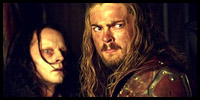 Because "The Lord of the Rings: The Two Towers" is the middle film in a trilogy, the picture has no official beginning or end. While this may seem like an automatic hindrance, do not forget that 1980's "The Empire Strikes Back" was the middle section in the "Star Wars" trilogy, and the best. Where "The Two Towers" fails is in its disposal of natural character development in favor of action, and in its confusion over where to go. The film is gorgeous to look at, the production design and visual effects are unmatched in their complexity, and Gollum is a complicated and poignant cinematic treasure. Unfortunately, "The Lord of the Rings: The Two Towers" is just one minute short of three hours and, thinking back on the entire film, almost none of the individual stories have progressed any further along.
Because "The Lord of the Rings: The Two Towers" is the middle film in a trilogy, the picture has no official beginning or end. While this may seem like an automatic hindrance, do not forget that 1980's "The Empire Strikes Back" was the middle section in the "Star Wars" trilogy, and the best. Where "The Two Towers" fails is in its disposal of natural character development in favor of action, and in its confusion over where to go. The film is gorgeous to look at, the production design and visual effects are unmatched in their complexity, and Gollum is a complicated and poignant cinematic treasure. Unfortunately, "The Lord of the Rings: The Two Towers" is just one minute short of three hours and, thinking back on the entire film, almost none of the individual stories have progressed any further along.
When the final chapter in "The Lord of the Rings" saga is released next year, entitled "The Return of the King," maybe "The Two Towers" will stand as a more respectable and meaningful bridge between the crucial first and last entries. On its own, however, it is a crushing disappointment of ill-advised missteps and misplaced opportunities. ©2002 by Dustin Putman |
 |













